I have an odd obsession with tape. I love the way it works, the way it sounds, the way it can be degraded, everything about it.
When I was a freelance designer and had a LOT of time on my hands, I did a lot of experimenting with tape. Almost entirely cassette tape. Why cassette tape you might ask? Cassette tapes and players are cheap, and readily available and if you break anything, you are at worst out a couple of bucks. I have destroyed about a hundred walkmen and other various tape players in the the past few years. If those were reel to reel recorders, I’d be broke by now.
I have built crude mellotron devices, tape theremins, loopers, loop mixers, crude tape delays, etc etc etc. The thing that started it all though, was the simple idea of the cassette tape loop.
In the time before detailed wikipedia articles the idea was just a rough concept that existed pretty much only in my mind and the minds of a few others, who to my shegrin were not very vocal about techniques. I ended up figuring out the Chandler loop (the name of which I just found via the wiki, which I also just found) and improving on it somewhat to get longer loops.
Here are the 3 basic looping techniques for cassettes:


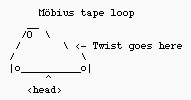
Here is a diagram of a standard Chandler loop: (yes the tape does rub in one spot, hence the modified version below)
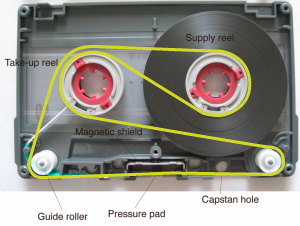
And here’s one of my Chandler loop cassettes, modified for longer play:
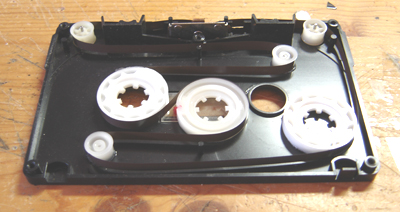
Initially, I was inspired by the idea of being able to build a self contained tape echo, a concept that eluded me until earlier this year, and functionally still does. Ideally I wanted to fabricate my own WEM Copicat. Of course, that’s an extremely complicated feat, especially for an electronics novice like myself, but I was obsessed with it, as I knew it was (if only faintly) possible.
So, in the process of breaking way more tape players than I care to admit I began to get more into the loops I was making than my original goal. I would randomly record music (original or otherwise) onto cassettes of various lengths and then play back the loop to see if anything accidentally musical happened. I’d play a few at once at times and improvise on accoustic guitar along with it.
My partner in crime complete with pitch control:
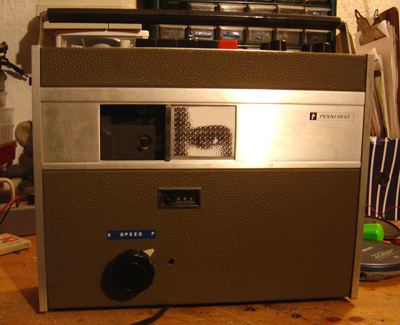
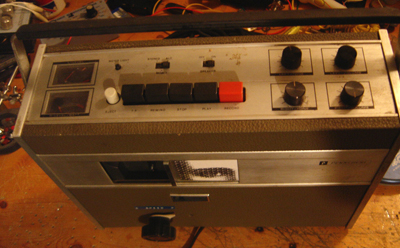
Eventually it occured to me to take the erase head off so that i could keep recording layer after layer onto the tape. This by far was one of the most exciting things for me at that time. It was so primitive and damn near uncontrolable, but it made the most amazing “instant music”. Some of the loops ended up actually being quite listenable for a period of a few minutes until you got sick of them.
The sheer nature of the process of recording these kinds of loops forces you to plan and limit yourself. Limits and planning are in my mind, some of the greatest assistances to creativity. You can fit a couple of tracks in before it geats to murky, so you have to record the least prominent thing first and work towards the most prominent. You have to be aware of the tape running so as not to overdub too many times. I recorded tons of stuff this way, most of which got promptly recorded over. It’s so much fun, it’s hard to stop fooling around with one loop, and before you know it, you record something too loud and it kills it.
At some point I got the idea to perform this destructive recording process, where I kept adding to the loop, then recording the result on my computer, then adding and recording again. I edited all of the bits together as one “piece” which is what I offer you today. I hope you enjoy it.
I have more cassette tape loop adventures to cronicle here, which is why this is titled “part 1”, so look for more in the future.
Tags: sound experiments
December 6, 2006 at 2:25 pm |
Oh wow, this is great stuff! I have also tried to build an echoplex– a neighbor of mine had a real one, which was a total inspiration to me. I got as far as creating a device that would READ from a tape loop (hand wound) at multiple points, but I never could master the erasing and recording, so it was fairly useless. At best, it was a cheap delay with very short times.
Any chance of posting a picture of a proper Chandler loop? I’m not the best with the ASCII art version, and it seems yours is modified from the ASCII picture, which gets me more confused.
December 6, 2006 at 3:18 pm |
Thanks for the comment! The delay unit I created was very rudimentary. It involved two open sided tape players and a loop that left one cassette and went into the other. It was more a “Frippertronics” type device than a true echo, but it was fun nonetheless. I recorded a bit of it and I still have it laying around, so details on that including audio will be in a future tape loop post.
When I get a chance later, I’ll add an image of a simplified chandler loop for all you non-ascii types 🙂
December 7, 2006 at 1:12 am |
What interesting layers of sounds. There is something special about tape.
September 2, 2007 at 9:37 am |
“Eventually it occured to me to take the erase head off so that i could keep recording layer after layer onto the tape.”
could you please tell me how i can do this with a regular tape deck? please e-mail me, thanks!
September 2, 2007 at 2:15 pm |
sure. every tape deck has a play head and erase head. the play head is the silver colored on in the center. the erase head can take a few forms, but since there are only two “heads” as long as you can identify the playhead identifying the erase head will be easy.
it generally has 2 wires. disconnect those and it will no longer erase. the catch is though, that at a certain saturation level you will no longer be able to add any more. at which point you will need to erase the tape to keep recording on it.
i hope that helps, if you need any further instructions, feel free to ask.
September 3, 2007 at 4:43 pm |
hi there…
how nice to see such thing!
first of all congratulation on your experiments…it is sounding great!
second, i am experiencing the same thing right now…completely fell heads over hills on tape loops… i read through your posts and found out that we read the same articles on wikipedia about how to make them and me too eventually customise my casstes with more spindles for longer loops…
I am using a 4 track and have 1 radio am static, 1 dictaphone, guitar and computer going into it… great fun…. and to top this 4-track of mine has aux send return on which I added an analog echo!
the interesting thing is i discovered the passion for tape loops at same time i bought ableton Live 6 and had decided movin forward on the technology music scale… oh boy… i still havent really played with Ableton, so much fun i am having with the tapes…
sometimes it seems going back is the only way to move forward!!! ( could this be an analogy to a tape loop itself???
September 4, 2007 at 9:20 am |
glad to hear about you experiments. they sound like a lot of fun. i have in my various musical travels flirted with “higher” forms of technology, however, something always lures me back to what could be termed “lo-fi” (though i would prefer a term like real-fi considering that music that is hi-fi seems to always be created in the most unrealistic of environments, not that i’m making a qualitative judgement here). i personally find that a lot of the qualities i appreciate about low-technology (unintentional sound, unpredictablility, lack of control) are the very things that high technology was invented to excape. not that i am dogmatic about my tastes, there is very “high-tech”, “high-quality” music i appreciate quite a lot, but for me as a maker, i’d rather my creation be as “dirty” as nature in all it’s glory.
glad you are digging the blog. thanks for commenting.
October 12, 2007 at 5:33 am |
hello. i only discovered the wonders of tape loop last week by reading this website… so thanku!!… i got very excited and made one of each type, although i havent yet made your adapted version of the chandler loop. i was just wondering if anyone new anything about phase shifting? im new to this field but im loving it!! so to make things go in and out of shift would you need say three things of the same length then set them off alternately, or do you need them to be different lengths and set them off at the same time? errrr…. does that make sense?!
October 12, 2007 at 11:55 am |
hey, flow, thanks for reading. glad you enjoyed the post.
it depends how much phase shift you want. any three tape players will play at slightly different speeds. (all of my recorders have been modded for variable speed, so i can do this manually) also, any three loops you make will be of slightly different lengths. the combination of these factors will result in a subtle but noticeably shift. if you want the phase shifting to be more overt, i’d mod some tape recorders. i have thought about doing a “how-to” post on this, i just haven’t gotten around to it yet.
thanks for reading and commenting!
February 6, 2008 at 12:13 am |
hey, nice read! – would there be any way to cover the erase head w/out having to disconnect it or take it out? – maybe it would be best to double up on the same cassette player and have one w/out the erase head and one with – i was also thinking of recording a loop on track 1 and then filling in the moment of silence (created by the erase head) on track 2 — AND THEN bouncing the tracks into one seamless loop…BUT wouldn’t there still be a silence created in the process of doing so? – uhh – anyone have any ideas?
February 6, 2008 at 12:49 am |
hey joshua, thanks for reading. glad you enjoyed the post. as far as i know (and i would know) no matter what you do, you will always have some kind of drop-out on cassette tape loops. it’s just part of the beast. after a while you sort of learn to take them into account or use them rhythmically. i could be wrong, but i’m sure the amount of fiddling it would take to get it seamless would take more time than it’s worth. for the most part these days i use 30 sec answering machine cassettes. they track well and are reliable, even though they do have a drop-out.
February 6, 2008 at 12:53 am |
oh, sorry joshua, forgot to answer your first question. if you do happen to make your own loops, you can route the tape so that it doesn’t pass the erase head. i don’t think you can just put tape over it, b/c it is magnetic, but experiment. i could be wrong. maybe there is a kind of tape that will work.
April 28, 2008 at 1:53 am |
Yes! I use cassette loops all the time to learn stuff.
Where to get the old cassette loop tapes? When the old cassette telephone answering machines were in, blank cassette loops were at Radio Shack and everywhere.
Now, no go. Anyone know where to get them please?
I’m too tech & craft ignorant to make my own. Thanks,
dogheartc@yahoo.com
May 5, 2008 at 3:23 pm |
hey, what length of tape do you use on a chandler loop?
great site, cheers.
May 5, 2008 at 3:37 pm |
thanks jim. but i don’t actually know. i usually just sort of wrap it around and clip it where is looks tight but not too tight. for what it’s worth i haven’t used one in a while, b/c they are just not as stable (in my experience) as regular loops. for the most part i use old outgoing message tapes.
just checked and this article says 14.5ish imches or 37.2ish cm.
http://en.wikibooks.org/wiki/Making_Cassette_Tape_Loops
May 5, 2008 at 6:50 pm |
cool! i am all for tape loops.
May 10, 2008 at 1:27 am |
im going to mess around w the chandler loop, thanks. ps id like to know more about tape theremins
May 13, 2008 at 2:14 pm |
i only ever did the photocell ones, which can kindo be fun, but are definitely not as cool or useful as a real gesture controller. below are some examples of gesture controller schematics, that soume members of the bendersanonymous yahoo group drew up. i think any of these could work, but i have not tried them.
http://www.et-ia.com/dropbox/0-5v-controller.jpg
http://www.et-ia.com/dropbox/ledpwm.jpg (this one is cool, b/c it varies the brightness of an LED, so theoretically it could be used with a variety of bent stuff in a sort of modular fashion. but alas, it is written in a kind of obtuse manner.)
http://www.et-ia.com/dropbox/PWM_driver_walkman.jpg
if you have success with any of these, please share!
December 23, 2008 at 4:20 pm |
tricky,, however 8 track loops are quicker and easier to do. but if u like cassette , by all means,, RUN WILD.. HAVE FUN VARIETY IS THE SPICE OF LIFE.. GGRR HAVE FUNNN…………….
January 6, 2009 at 5:46 pm |
hi,
i recently tried the basic tape loop. i became very angry with the tape, it kept comming out etc. etc etc. any tips???
January 8, 2009 at 10:30 am |
tyler, they can be tedious for sure. i generally avoid using my finders to align the tape with the heads, as they are just too clumsy for such fine work. i usually use a combination of small jewelers screwdrivers and tweezers. just be patient and make your moves percise and eventually it will come together. hope that helps. thanks for visiting!
April 13, 2009 at 5:49 pm |
do you know how a one sided/one way cassette tape is threaded? i see how the Chandler loop is done, very interesting!
thank you
April 15, 2009 at 10:17 am |
Carrie, you just thread the tape right around the reels. See the ascii diagrams above. you have to experiment a bit with tape lengths, but it’s pretty much just a loop around the reels.
November 16, 2009 at 8:48 pm |
I have a Q, when you make a tape loop do you record onto the loop. Confusing to ask, but what i mean is do you already have the material you want to loop on the cassette before you cut it and stick it in a shell or do you make a loop stick it in a recorder then record while it’s looping.
I ask because i have made a few tape loops using splicing tape and nice 45 deg angles on the join, but they always come out sounding like…well shit.
November 21, 2009 at 11:10 am |
i record onto them after i make them.
about them sounding like shit, you have to be realistic about what you are doing. you are hacking something in order to perform an unintended purpose. this almost never results in great fidelity. so if you want it to sound like a WEM echo, give up now. personally, i like tape looks specifically because they sound “like shit”.
April 21, 2010 at 4:56 pm
hey good answer ! surely “sounding shit” is partly the point of making this stuff! I haven’t made any tapeloops since I was 13 (I’m now 42) and thought I’d revisit the technique. I’m forming a one-finger analogue synth band with a bunch of old shit – what better backing than a cassette tape loop?
Incidentally do you know which manufacturer used the screw together shells rather than the welded ones?
January 27, 2012 at 7:24 pm |
[…] Different types loops here […]
February 2, 2012 at 9:06 am |
led strip…
[…]Wonders of the cassette tape loop, part 1 « OF SOUND MIND[…]…
May 9, 2012 at 12:06 pm |
what length do you use for the standard ?
May 9, 2012 at 1:26 pm |
i honestly have no idea. i just wrap the tape around a cut it to whatever seems like a decent length. been meaning to experiment with whether using the reels for forward tape movement is even necessary. in reel to reel looping, you don’t usually use them, and the capstan on a cassette deck works in essentially the same way. thus, you could probably cut it to whatever length fits inside the cassette case, and it’d likely work fine.
May 24, 2012 at 4:48 pm |
Hey – I love the description and PHOTOS you included are really helpful. I have a quick question (crossing my fingers you still read your comments on such an old post) …
How exactly do you go about adding in those extra spools? Are they stationary and simply glued into place? I’d like to create loops of various lengths by adding spools and rerouting the tape throughout the shell.
May 25, 2012 at 9:53 am |
Hi, yes, I don’t post here anymore, but I do keep up with comments and questions.
The extra spools are simply glued in place. They don’t rotate, so I’d keep the tape on the loose side.
It’s also worth noting, that I’m not positive they are necessary. The capstan does the bulk of work in advancing the tape, and the reels themselves are not completely necessary. I’m pretty sure you could load as much loose tape in there as you wanted, as long as it was in a way where it won’t tangle.
Hope that helps!
June 1, 2012 at 12:49 pm |
Hey, thanks for replying back. I appreciate you taking the time on such an old post. I finally brought some tapes home and will starting some projects of my own. I’ll see if I can include your technique here. If I accomplish anything of interest I’ll let you know.
September 15, 2013 at 6:16 pm |
Glad I found this page, if only for the images of different ways to load tape into the cassette shell! Surely there are other options out there to consider – interesting to think about! I was thinking recently about the concept of routing the tape away from the tape path immediately following the record head, down into the cassette and around, then up again to the playback head – likely easier said than done, but certainly not impossible.
Anyway, being that I’m working on my own delay unit at the moment and using the echomatic as my template, my question is this – how do you deal with the circuitry related to routing, impedance and amplification, especially after adding a head to an existing tape machine? It seems the unit I’m modifying is throwing a few obstacles my way, by way of a mono headphone out being the only output (aside from speakers) and the only apparent input being a built in mic element. I’m sure I can suss that out eventually, but really not sure where the newly added record head will be routed..
September 16, 2013 at 7:08 pm |
Hi Steve. The echomatic is a really interesting device. Definitely one of the simpler tape loop mechanisms I’ve seen. I made some attempts to turn junked cassette stuff into an echo machine years ago, but didn’t get far with it. There are a number of issues to deal with that eventually lead me to give it up. Firstly, getting a machine to record and play back at the same time. Most machines use the same head for that, and typically there’s a big multi-pole switch that switches between two sets of circuitry, making it nearly impossible to isolate them, and then reconfigure them to work in consort. Then there’s issues with setting up a tape path across all your additional play heads, that has proper tension and is adjustable enough to deal with tape wear. IMO you’d have to have several isolated bits of circuitry, a custom box, and a bunch of additional circuitry specially designed to make it all work. After banging my head against it for several hours, I realized I just wasn’t interested in re-engineering something that already existed. It would likely take me a hundred or so hours to even come close, at which point it’s more economical to just buy a vintage loop machine.
I decide my efforts were much better devoted to being creative musically with much simpler devices.
For instance, if you had 3 cassette player/recorders, you could probably come up with a way to route tape from the first one, which is set to record, to the others, which are set to play. You could probably get some really interesting sonic results but taking advantage of all of the weird sounds this would probably create due to errors in the tape feeding. Just a thought.
Best of luck
October 9, 2014 at 6:02 am |
[…] https://ofsoundmind.wordpress.com/2006/12/05/wonders-of-the-cassette-tape-loop-part-1/ […]
July 5, 2015 at 8:41 am |
i find tarific
July 5, 2015 at 8:43 am |
i find it terific
March 7, 2016 at 11:23 pm |
Just found this great post. Thanks for all the info!
I’ve recently wanted to experiment with the endless overdubbing that you wrote about. Rather than removing the erase head from my tape recorder, I just rerouted the tape inside the cassette so that it wouldn’t touch the erase head.
It now works to overdub endlessly, but I’m wondering, is there any way to monitor the loop as you record more layers?
March 30, 2016 at 10:40 am |
That’s another way of doing it, yes. I also tried attaching a switch to the erase head to deactivate it momentarily, but it never really worked that way. As for monitoring, that’s a difficult challenge. I’ve actually tied adding additional playheads to tape recorders, but it’s very difficult for a number of reasons. the closest you can get is adding a second tape recorder which is set to play mode. However, even this is very difficult. You’d need to have one loop of tape going between two cassette players, and both players would need to be modded.
As far as I’m concerned, none of this is really worth your time. Just have fun making blind overdubs on cassettes. If you want to do anything higher tech than that you’re better off moving to reel to reel tape machines. Making loops is really easy, and using two machines to overdub is pretty simple. You can even keep adding machines if you really want to get crazy.
Hope that helps.
June 16, 2016 at 6:35 am |
“I’m wondering, is there any way to monitor the loop as you record more layers?”
Hi prettyfunbird@gmail.com:
I guees you would need a three heads tape recorder. Most of them only have two heads (one for erasing and other for recording and playing).
But other models use separate heads for playing an recording so you can switch what you want to listen to; sounds from tape or sounds from input.
May 30, 2017 at 10:25 am |
I want to study creative writing in college. As in to become a novelist or possibly screenplays. It doesnt really matter where as long as its an english speaking country. Anybody have any ideas of where would be best?.